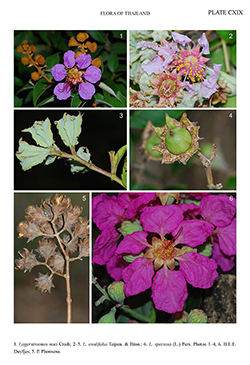e-Flora of Thailand
Volume 11 > Part 4 > Year 2014 > Page 574 > Lythraceae > Lagerstroemia
13. Lagerstroemia speciosa (L.) Pers.wfo-0000366693
Syn. Pl. [Persoon] 2(1): 72. 1807; Furtado & Srisuko, Gard. Bull. Singapore 24: 264, f. 29A. 1969; P.H.Hô, Ill. Fl. Vietnam 2(1): 25, f. 3662. 1992; S.Gardner, Sidisunthorn & Anusarnsunthorn, Field Guide Forest Trees Northern Thailand: 206: 450. 2000.— Munchausia speciosa L. in Münchh., Hausvater 5: 357, t. 2. 1770. Plate CXIX: 6.
Accepted Name : This is currently accepted.
Synonyms & Citations :
Description : Trees 5–30 m tall; bark light brown, black when old, coarsely vertically cracked and slightly flaking (inthanin). Leaves: petiole 0.5–1 cm long; lamina membranous or chartaceous, glabrous, dull, elliptic or obovate, 10–20 cm long; lateral veins (6–)8–14 on each side; intercostal venation reticulate or reticulate-scalariform. Inflorescences terminal, lax or elongate, 15–25 cm long, when young densely short stellate-hairy, becoming glabrous. Flowers: bud short-farinose, subglobose, ca 0.5 mm nippled at apex, ca 8 mm diam., pseudopedicel 3–8 mm long; calyx tube 6–8 mm long, distinctly 12-ridged, the ridges low; calyx lobes glabrous within, to 8 mm long, auricles between the sinuses absent or as minute warts; petals purple, blade obovate, ca 20 mm long, upper part of margin irregularly undulate, claw ca 5 mm long; stamens numerous, monomorphic (all of about the same length); ovary glabrous. Capsules brown or black, dull, smooth (not shagreen), glabrous, 15–25 mm long, 6-valved; fruiting calyx 12-ridged, the ridges not winged; calyx lobes glabrous within, ± thin, often reflexed, without auricles; fruiting pseudopedicel 5–10(–12) mm long.
Thailand : NORTHERN: Mae Hong Son, Kamphaeng Phet; EASTERN: Nakhon Ratchasima (Pak Chong-Khao Yai NP); SOUTH-WESTERN: Kanchanaburi (Khwae Noi Basin, Thung Yai Naresuan WS, Sangkhla Buri), Ratchaburi (Hin Dat), Prachuap Khiri Khan (Ban Pan Tawan); CENTRAL: Nakhon Nayok (Khao Yai NP [cultivated]), Krung Thep Maha Nakhon (Bangkok); SOUTH-EASTERN: Chanthaburi; PENINSULAR: Chumphon (Bang Son, Ta Ngo), Ranong (Kapoe), Pattani (Betong, Nikhom Kua Long), Narathiwat (Waeng).— Commonly planted as an ornamental tree throughout the country.
Distribution : India (type of Lagerstroemia reginae), Myanmar, China (Yunnan), Cambodia, Laos, Vietnam (probably only cultivated), Peninsular Malaysia, Indonesia (Sumatra, Borneo (Sarawak, Sabah), [Java and China – lectotype of L. speciosa: Herb. Linn. No. 939.1 -LINN], Sulawesi), the Philippines, cultivated elsewhere.
Ecology : Trees of deciduous and evergreen forests, along rivers; sandy, and (rugged) limestone bedrock; from sea level to 750 m alt. Flowering: February–May; fruiting: April–January.
Vernacular : Tabaek dam (ตะแบกดำ)(Bangkok); inthanin (อินทนิล), inthanin nam (อินทนิลน้ำ)(Central, Peninsular); chuang-mu (ฉ่วงมู), chong-pha-na (ฉ่องพนา)(Karen-Kanchanaburi); ba-ngo-ba-sa (บางอบะซา)(Narathiwat); ba-ye (บาเย), ba-e บาเอ (Malay Pattani).
CommonName : Pride of India, Queen’s crape myrtle
Uses: Ornamental tree, commonly planted along roads; the inflorescences are exserted from the general crown of the tree; the wood is employed as timber.
Notes: Lagerstroemia speciosa is variable in size of flowers and fruit, length of fruiting pseudopedicels, and in the colour of the flower buds, viz. more ashy grey or brownish, and in the distinctness of the calyx ridges. The acuminate apex of the calyx lobes is often broken off.
Lagerstroemia speciosa can be confused with L. macrocarpa, the latter generally stouter with a larger corolla and fruit, and with a stronger long fruiting pseudopedicel.
The leaf apex is short acute-acuminate, with the very tip quite often somewhat shrivelled or deformed. In the related Lagerstroemia macrocarpa this phenomenon seems the rule, with the result that in this species the leaf apex is (always?) rather rounded, not acute-acuminate.
Furtado & Srisuko (1969) keep Lagerstroemia speciosa and L. reginae (‘flos-reginae’) as separate species, but the differences as seen in the numerous herbarium specimens studied, as well as the differentiating characters presented by Furtado & Srisuko (1969, key p. 259) do not warrant a practical distinction.
Gardner et al. (2000) consider the species not to be native in northern Thailand, but commonly planted there.
All filaments are purple, all with yellow anthers.

